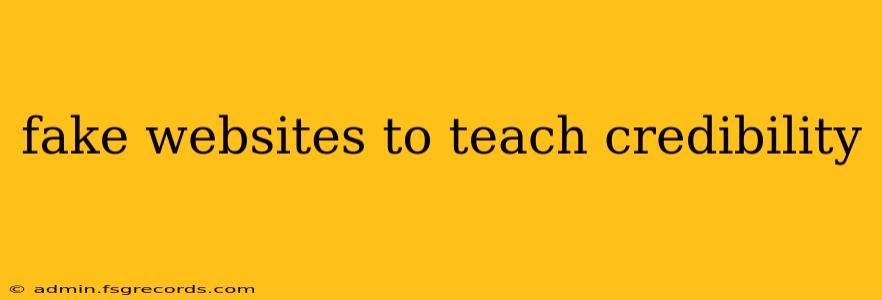The internet is a vast landscape, brimming with information, but discerning truth from fiction is a crucial skill in the digital age. Teaching credibility online, especially to younger audiences, presents a unique challenge. One surprisingly effective method involves strategically using fake websites as teaching tools. This isn't about deception, but rather a controlled environment to highlight the red flags of misinformation and demonstrate how to evaluate online sources critically.
Why Use Fake Websites for Education?
Real-world examples of misleading websites are often complex and entangled with legal or ethical considerations, making them unsuitable for educational purposes. Constructing fake websites, however, allows educators to create controlled scenarios that clearly illustrate the hallmarks of unreliable sources. These can be designed to showcase specific deceptive tactics, such as:
- Misleading domain names: A website might use a domain name subtly similar to a reputable organization (e.g., replacing a single letter or using a less common top-level domain like
.netinstead of.org). - Poor design and unprofessional layout: Websites with unprofessional design, grammatical errors, and inconsistent formatting are often a strong indicator of unreliability.
- Lack of contact information: Legitimate organizations usually provide contact details, including email addresses and physical addresses. The absence of this information can be a red flag.
- Biased or unsubstantiated claims: Fake websites often present information without credible sources or rely heavily on emotionally charged language to persuade the reader.
- Excessive advertising or pop-ups: Overly intrusive advertising can be a sign of a website prioritizing profit over factual accuracy.
Creating and Utilizing Fake Websites in Education: Best Practices
Creating a fake website for educational purposes requires careful planning and ethical considerations. It's crucial to be transparent with students about the exercise's nature. Here's how to approach it responsibly:
1. Transparency is Key:
Before introducing the fake website, clearly explain to students that they'll be analyzing a purposefully created example of a misleading online source. This prevents confusion and ensures they understand the context.
2. Focus on Specific Tactics:
Instead of creating a broadly misleading website, focus on a single deceptive tactic. This allows for more focused analysis and deeper understanding. For instance, one fake website could concentrate solely on a misleading domain name, while another focuses on biased language and unsubstantiated claims.
3. Design a "Fake Website Scavenger Hunt":
Turn the exercise into an interactive game. Provide students with a checklist of elements to look for (e.g., contact information, author credentials, evidence of bias). Reward them for correctly identifying the red flags.
4. Post-Analysis Discussion:
Following the analysis, facilitate a class discussion where students share their findings and insights. Discuss the importance of media literacy and the potential consequences of believing misinformation.
5. Explore Real-World Examples (carefully):
Once students understand the principles, briefly discuss some real-world examples of misleading websites, always emphasizing caution and responsible sourcing. Avoid delving too deeply into potentially harmful or misleading content.
Conclusion: A Powerful Teaching Tool
By carefully creating and utilizing fake websites, educators can provide a safe and effective way to teach media literacy and critical thinking skills. This hands-on approach allows students to actively engage with the material, leading to a deeper understanding of how to evaluate online information critically and make informed decisions in the digital age. Remember, the goal is not to deceive but to empower students with the skills to navigate the complex information landscape responsibly.

